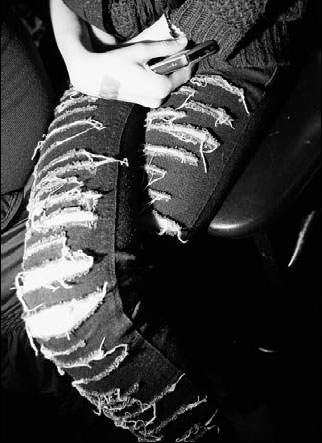Shredding as a form of rebellion
By Ruth La Ferla (中国日报)
Updated: 2010-08-22 10:09
 |
Large Medium Small |
 |
|
Shredded jeans reflect a mood not unlike punk in the '70s and grunge in the '80s. All kinds of fashion wear, from coats to T-shirts to shoes, are being shredded. Elizabeth Lippman for The New York Times |
At a glance there is not much glamour in a coat or T-shirt that seems to have been run through a paper shredder. But to Joie Reinstein, that diced and torn look, which she first glimpsed two years ago in a Rodarte fashion show, represented the tatty quintessence of chic.
The collection "featured those crazy clothes with holes in them," she recalled. "When it was released on the runway, it felt different from everything else."
Earlier this year, Ms. Reinstein and her classmates in a fashion history course at Parsons the New School for Design in New York, revisited that theme for an assignment to try and identify fashion's next frontier. Their mission was to find a macro trend, one with the staying power to shape the future of design.
"We were trying to ask, 'What does the new horizon look like?' " said Geetanjali Rastogi, one of 25 students in the class. Their findings were screened in class and posted on the Web site fashiontheory.org.
They discovered that jeans and leggings, shirts and even shoes that seem to bear the marks of Freddy Krueger are the elements of a phenomenon that has, it turns out, a darkly subversive cast. Shredding, one of several trends the class explored, can be a form of rebellion.
For as Sarah Cassar, a student, put it, "Your mom wouldn't want you wearing those clothes."

Despite that aggressive subtext, slashing, which dates at least from the age of Henry VIII, can be an expression of subtle refinement and luxury. That surely appealed to Christophe Decarnin, whose spring collection at Balmain highlighted a succession of beat-up-looking officer's coats ripped to reveal not the brocades of Henry's day but a rich underlayer of glistening gold mesh.
The students' classwork revealed that the trend, which tends to surface in periods of social upheaval, first appeared during the punk movement of the 1970s, in the shape of threadbare clothes precariously fastened by safety pins.
Today ripped jeans, fraying shirts and laddered stockings stand in metaphorically for a disintegrating social climate, Katie Fleming, another student, noted. It is a trend, she said, that transcends mere clothing to become a metaphor for changing times and "a statement of personality."
Shredding, her classmate Christine Kim added, represents an intentional casting-off of outworn selves. "People are losing their jobs and abandoning old habits," she said, and, in consequence, "opening themselves up to areas they haven't explored."
They are trying, Ms. Fleming chimed in, "to disengage, shredding their identities and searching for new ones."
Sliced and razor-chopped clothes attest to much the same mood of unease that spawned the music and fashions of grunge in the '80s and early '90s.
In an era today marked by "oil spills and strange volcanic eruptions," Ms. Reinstein observed, shredding can be about "taking control of our world and refashioning it - but in our own terms."
The New York Times